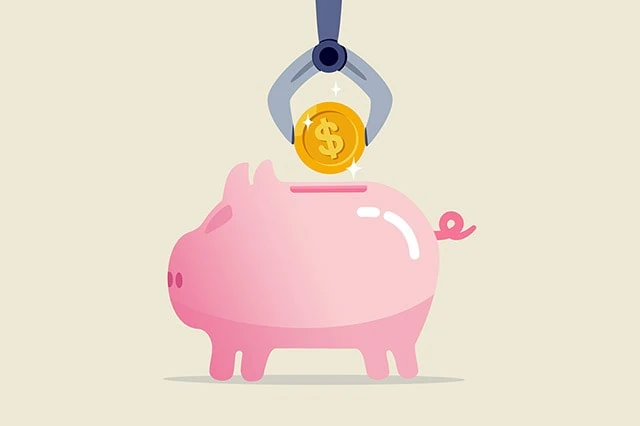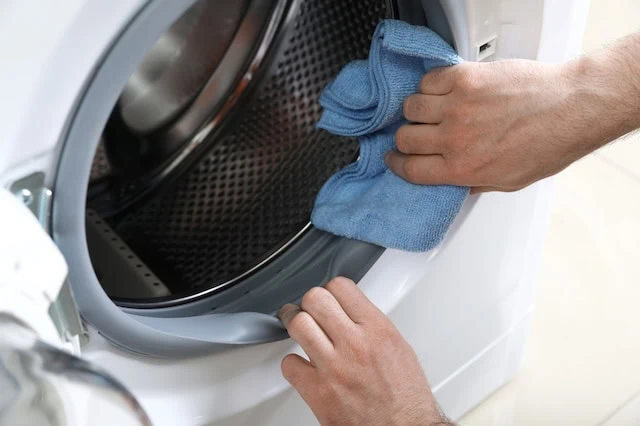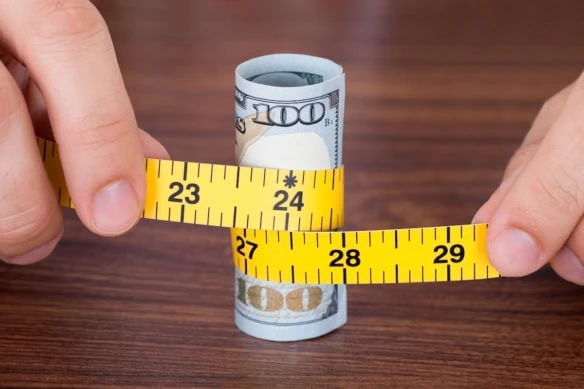A minimalistic lifestyle focuses on the concept of “less is more.” It can mean you purposely live with few possessions and prioritize quality over quantity. You keep what’s valuable and eliminate the excess to keep your mind and physical space decluttered.
Financial minimalism runs along a similar vein. You limit your spending and try to reduce the number of tasks on your financial checklist, which in turn can reduce your stress and increase your worth.
Sound appealing? Today, I’ll explain some of the best ways to achieve financial minimalism. These methods, over time, should not only benefit your wallet—they should help you spend less time thinking about money and more time just enjoying life.
Featured Financial Products
Tips for Becoming More Financially Minimalistic

Managing your finances can be stressful, even if you have more than enough money to get by.
In a 2024 survey conducted by Discover Personal Loans, 80% of respondents said they feel “some level of anxiety” about their financial situation and 34% said they feel “moderate or severe anxiety” about it.
Even with a strict budget, you might find yourself losing money every month, or perhaps just not having as much left over as you expected. You might spend longer on bills than you expect. You might constantly worry about your net worth but never seem to know what it actually is.
Let’s go over some of the ways you can adopt a more minimalistic mindset toward your finances, which may simplify your tasks and even tamp down your economic anxiety.
1. Automate Your Finances

Whether you sometimes forget to pay bills (and rack up late fees) or you simply get flustered by manually paying bills, you can improve your life by automating your finances as much as possible. Among the easiest steps you can take:
- Putting bills on autopay
- Setting up recurring bank transfers to send money regularly from your checking account to your savings account.
- Setting up paycheck deductions to a retirement account
Automating your finances offers multiple benefits. For one, your payments will always be on time. It also ensures that you aren’t just saving whatever money is left over after your discretionary spending—it makes paying bills and setting aside money the main priorities. And in a few cases, companies will actually take a few dollars off your bill for setting up autopay.
But even though you’re clearing out most of the manual work, you’ll still need to regularly examine bank and credit card statements to ensure you’re not falling victim to errors or fraud.
Related: How to Reverse Budget With ‘Pay Yourself First’ Budgeting
2. Consolidate Your Financial Accounts

Do you have eight different brokerage accounts you opened for the sign-up bonuses? Or maybe you have a workplace retirement account from your last six jobs. It’s easy to accumulate a lot of financial accounts. Unfortunately, having your money spread out everywhere can make it challenging to keep track of your net worth and trajectory.
Simplify your finances by holding your money in fewer places. Consider doing a 401(k) rollover to consolidate your retirement accounts. Stick to your favorite taxable brokerage account instead of having several apps holding the same fractional shares of stocks. If you still have an old checking account in your hometown that doesn’t have a branch where you currently live, feel free to close it out and just have an account with a bank nearby or an online-only bank.
Related: How to Protect Your Wealth: 10 Proven Strategies
3. Use the 30-Day Rule to Buy Less

The 30-day rule helps you avoid making impulse purchases you may regret later.
The rule is simple: If you’re about to make an unplanned purchase, pause, then wait 30 days. If you still want it, get it.
Let’s say you see a dress you love online and you’re tempted to buy it. If you wait 30 days and still want it, the rule allows you to make that purchase. However, many times, a little bit of time will make an item less appealing than it was initially—possibly because you’re in less of a “retail therapy” mood, or possibly because you realize the item simply isn’t worth it.
Overall, though, the 30-day rule not only helps you be more minimalistic by helping you purchase fewer things—but it also ensures that you really do want the things you end up buying.
Related: How to Make Your Money Work for You: 7 Mighty Money Moves
4. Think of Your Purchases in Terms of Time Worked

The cash in your wallet isn’t Monopoly money. You worked hard for those funds.
Most people forget that connection as soon as their paycheck hits their accounts. But remembering that connection—by thinking of purchases in terms of time worked—can help curb your spending.
You see a sweater on sale for $100. Clothing is functional and you like the way this particular piece of clothing works. But let’s say you earn $20 per hour—does that sweater feel like five hours’ worth of work to you? It might! But when you reframe all purchases this way, you might end up making fewer discretionary expenditures.
Related: Best Savings Account Alternatives [9 Other Ways to Save]
Featured Financial Products
5. Focus on Quality, Not Just Price

Financial minimalism isn’t about always buying the cheapest items to save money. Some items are worth splurging on—in fact, sometimes, the most frugal step you can take is buying something that costs a little bit more but will last several more years than the cheaper version (if not forever).
For instance, cheap, nonstick pots and pans must be replaced every few years, while stainless steel and cast-iron cookware is more expensive but can last decades.
Example: You’re choosing between an inexpensive nonstick pan and a more expensive stainless steel pan. The first pan costs $50 and will last five years. The second pan costs $100 and will last 20 years. Over the course of 20 years, you’ll spend $200 replacing your first pan every five years—but just $100 on the steel pan, which won’t need to be replaced at any point during that time. In this situation, buying the inexpensive pan is merely cheap, while purchasing the pricier pan is actually frugal.
Buying items that last also cuts down on another expensive practice: Buying new versions of items anticipating that they’re going to go bad (even if they won’t anytime soon).
And as a bonus, buying more durable items less frequently is more sustainable and better for the environment.
6. Do Your Research

Carpenters and seamstresses often repeat the adage to “measure twice and cut once.” The purpose is to make sure you have accurate measurements before cutting … because if you cut something too short, you can’t undo that action.
Apply this idea to your shopping.
When you need to make a large purchase, do your research. Take my advice from and factor in not just price but quality to ensure you’ll actually getting long-term value out of the purchase.
I can’t promise you’ll only need to buy everything once—some things are designed to last a lifetime, but some technologies become obsolete. Still, a little analysis can save you a lot in the long term if you keep yourself from needing to buy the same thing over and over again.
Related: Frugal vs. Cheap: What’s the Difference?
7. Track Your Spending

“Where did all of my money go?”
If you ever find yourself asking this at the end of the month … well, I can promise you your money isn’t just evaporating into thin air. It’s being spent on something somewhere.
And you need to track it.
While tracking your expenses will complicate your life a bit more at first, it helps set a benchmark for budgeting. Keep track of when and how much money is going in, as well as when and how much money is going out—and where that money is going. After a few months of careful tracking, you might discover that you’re spending more in certain categories than you ever realized. And these insights may help you eliminate any unnecessary expenses.
For instance, you might notice you go out to dinner more often than you thought, or that you constantly buy single-use water bottles (and could save money by purchasing a water filter and reusable bottle).
Sometimes you might identify more costly issues. For instance, a gradually growing energy bill (without a change in your energy usage or generation prices) can be a warning sign that you have a faulty HVAC system that must be repaired or replaced.
8. Hire a Financial Advisor

If time is money, consider how much of your money you might be throwing away by shouldering all of the burden of long-term financial planning and making investment decisions.
A professional financial advisor won’t work for free, of course. But the benefits frequently outweigh the costs.
A financial advisor can ensure your portfolio has an optimal mix of risk and reward, prevent you from making costly mistakes during a market panic, help you avoid the temptation of too-good-to-be-true opportunities … and that’s just on the investment side. Financial advisors can also draw up a savings plan that actually works for you, and even save you money each year by minimizing your obligations to the tax man.
Not to mention: All of the above should help you spend far less time sorting your money.
Related: 13 Best Long-Term Stocks to Buy and Hold
9. Take Care of Your Items (And Self!)

Want to buy fewer things? Take care of what you have!
Stay on top of your vehicle’s regular oil changes and tire rotations. Put a case on your smartphone. Use a mattress protector. Keep your electronics clean. Stash your glasses in a case.
In general: The more expensive the item, the more routine maintenance and care you should be putting into it to extend its maximum useful life.
And for that matter? Take care of yourself, too. Dental floss is much cheaper than a root canal. Sunscreen is more affordable than skin cancer treatment. Keeping yourself healthy (as much as is in your control) is much more affordable than fixing issues—and, of course, will have massive quality-of-life benefits, too.
Related: 10 Frugal Habits That Will Improve Retirees Lives
Featured Financial Products
10. Trade Skills + Share Items

Sure, Tiffany probably won’t trade you a diamond bracelet for a year’s worth of plumbing services. But if you’re a particularly skilled tradesman or hobbyist, the occasional barter might be worth pursuing.
Does your elderly neighbor struggle to snow blow his driveway? Offer to do it for him in exchange for borrowing that snowblower for yourself. Love baking? Offer up some baked goods to a friend in exchange for some of their chickens’ eggs.
Just be careful with the social aspect of this tip. You don’t want to make your relationships feel too transactional—do some favors without asking every time what’s in it for you. People like to do favors for people who have helped them out in the past, but looking for compensation every time will drain you of any goodwill.
Related: How Much to Save for Retirement by Age Group
11. Ignore the Kardashians

“I saw Cady Heron wearing army pants and flip flops, so I bought army pants and flip flops.” —Mean Girls
Don’t let yourself feel financially victimized by celebrities or your acquaintances’ social media personas.
Adults might roll their eyes at their teenagers insisting they need to wear American Eagle clothing and Converse shoes because that’s what their peers are buying. But the need to have what others do doesn’t always go away with age. An adult might buy the designer purse a favorite celebrity was touting or the same fancy lawnmower a neighbor has.
Don’t let peer pressure, or a fear of missing out, compel you to buy something you don’t need (and possibly don’t even want).






![SEP IRA Contribution Limits [2025 + 2026] 27 SEP IRA contribution limits](https://youngandtheinvested.com/wp-content/uploads/SEP-IRA-contribution-limits-600x403.webp)

